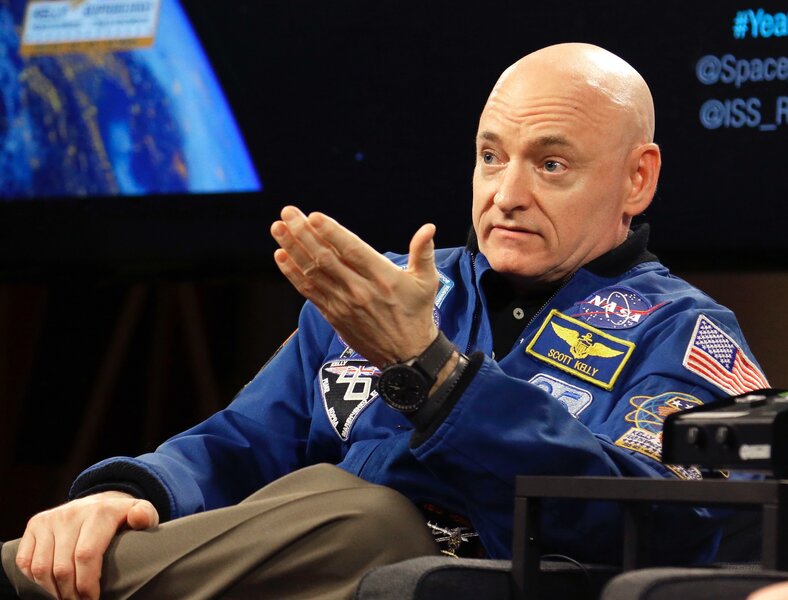Scott Kelly's epic year in space: Is NASA any closer to Mars?
Loading...
A subdued and exhausted Scott Kelly was peppered with questions Friday about his adjustment to life back on Earth after his record-breaking year in space, which ended when he landed in Kazakhstan on Tuesday.
At an event at the Johnson Space Center in Houston, Mr. Kelly said that the extra six months he spent on the International Space Station (ISS), double the time that any other American has spent there, had taken its toll. Over the course of his three missions to the ISS, Kelly has spent a total of 520 days in space.
“I thought it would probably be a little different, but it’s more than just a little different,” said Kelly. “Coming back to gravity is harder than going to no gravity,” he said.
Adjusting back to the tug of gravity, after floating freely in the weightlessness of space, has left his body sore and fatigued. His skin is more sensitive, he said, as he shifted restlessly in his seat.
His aim is also off. “I tried to shoot some basketballs and didn’t get any in the net,” said Kelly.
For months to come, scientists will poke and prod the astronaut to study the physical and psychological effects of long-term space flight. The findings from that research – especially those comparing Kelly’s health to that of his twin brother Mark, who spent the year on Earth – will be published in about a year, said NASA. They will inform preparation efforts for future human missions to Mars, each of which would last 2 to 2.5 years.
When that future might come is difficult to predict. Though the idea of exploring Mars has ignited the passion of the public, which eagerly followed Kelly’s space journey through his consistent dispatches on social media, the challenges associated with sending humans to the distant planet are daunting.
It could take many more Scott Kellys, each spending a year in space, before NASA feels confident that such a long mission is safe for humans.
“We’re looking at as many as ten,” Doug Wheelock, a NASA astronaut and the incoming director of NASA’s office at Star City, the Russian space agency’s headquarters outside of Moscow, told Time magazine.
“And to get a good data set we need a good mix of subjects, which means women and men, older crew members and younger ones, veterans and first timers. There’s a lot we have to learn,” he said.
Besides the human tests still required, there is the matter of deciding whether the United States should even aim for Mars. There isn’t agreement among NASA, Congress, and the White House on whether the country can or should make the trip.
“Today, the future of the human spaceflight program is far from clear, with many pieces that are yet to be defined and funded,” testified Tom Young, a former NASA director, at a recent US House Committee on Science, Space, and Technology hearing on the subject.
The National Academies of Sciences, Engineering, and Medicine in 2014 said that NASA's current plans for getting humans to Mars in the 2030s are unrealistic, according to Pasadena, Calif.-based Planetary Society, an advocacy organization that backs the goal of going to Mars above all else.
The academies calculated that NASA could not get humans to Mars earlier than 2046, and even then, only with a massive increase in congressional funding for the space program. In fiscal year 2017, that budget is $19 billion. Many people think more funding is unlikely.
And if it was, how much more would NASA need? Since nobody knows what it will technically take to get humans to Mars, there is not a clear estimate of the such a journey's price tag. Rough estimates have ranged from $30 billion over 10 years to about $100 billion over 30 years.
The Obama administration has called on NASA to begin crewed missions beyond the moon by 2025, including sending astronauts to an asteroid. By the mid-2030s, says the administration, NASA should send humans to orbit Mars and then return them safely to Earth.
Last year, NASA announced a $1.25 billion plan to send a solar-powered robot to an asteroid in 2020 to pluck a boulder off its surface, drop it in orbit around the Moon, and then send astronauts aboard a spacecraft called Orion, in development now, to the space rock in order to explore it.
But some space experts say that the asteroid exercise is futile and does not push technology far enough along to be of use to a future mission to Mars.
There are no human missions planned beyond the Moon or to Mars, and the technology that would be needed to do that is in its infancy.
But the very fact that NASA is starting to build the technology that could support a deep-space mission, such as Orion and its launch system, may be a positive sign, since the agency had not focused on building vehicles for human space flight in decades, says Casey Dreier, director of space policy for the Planetary Society.
“NASA is further along to its path to Mars than it ever has been before,” Mr. Dreier told The Christian Science Monitor.
NASA’s specific plans for Mars might become more clear in the next year, as there is now a sense of urgency to create a definitive roadmap before a new presidential administration takes over.










